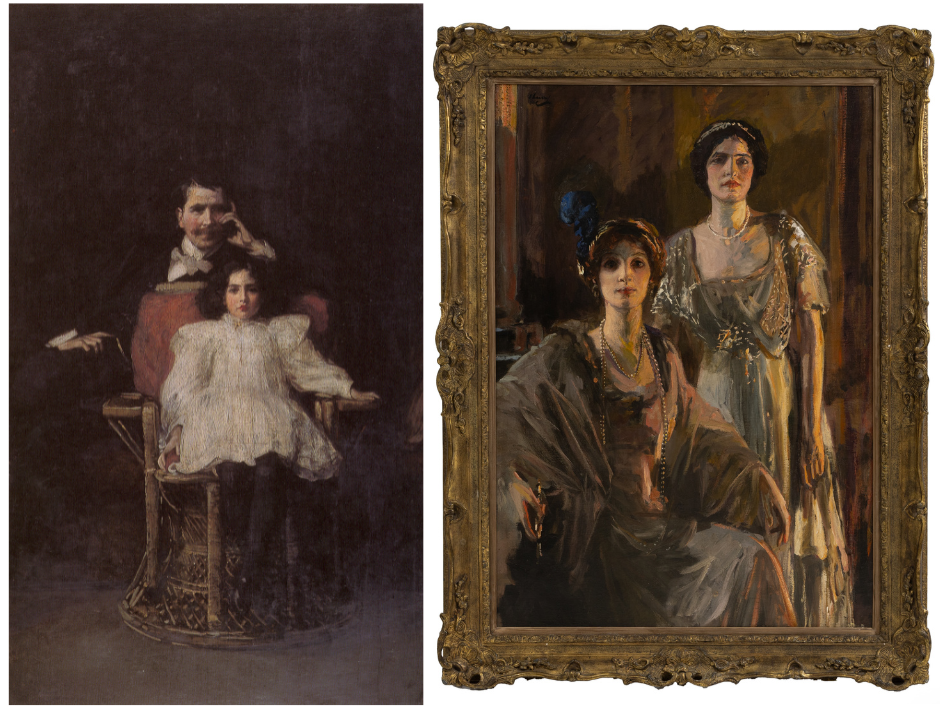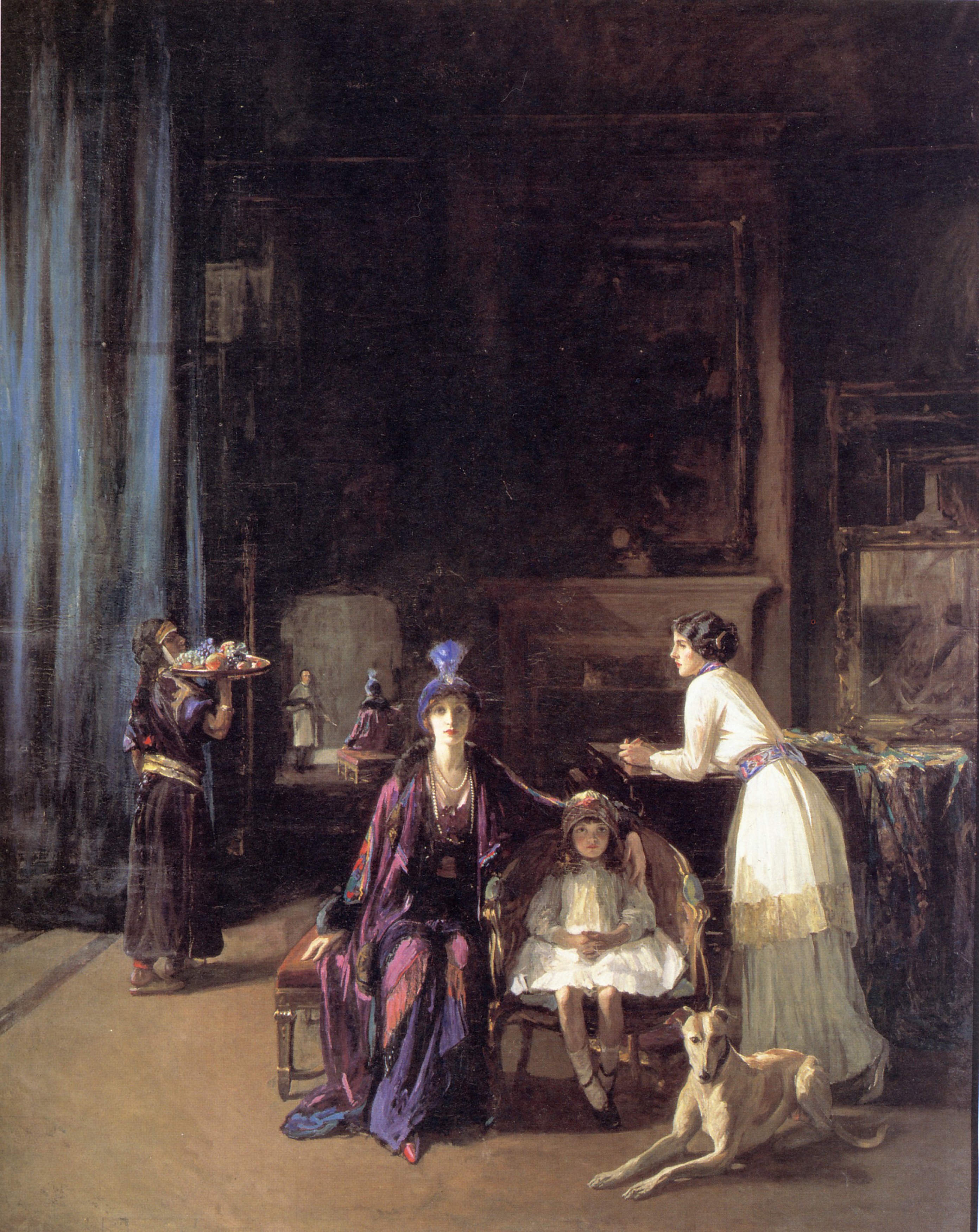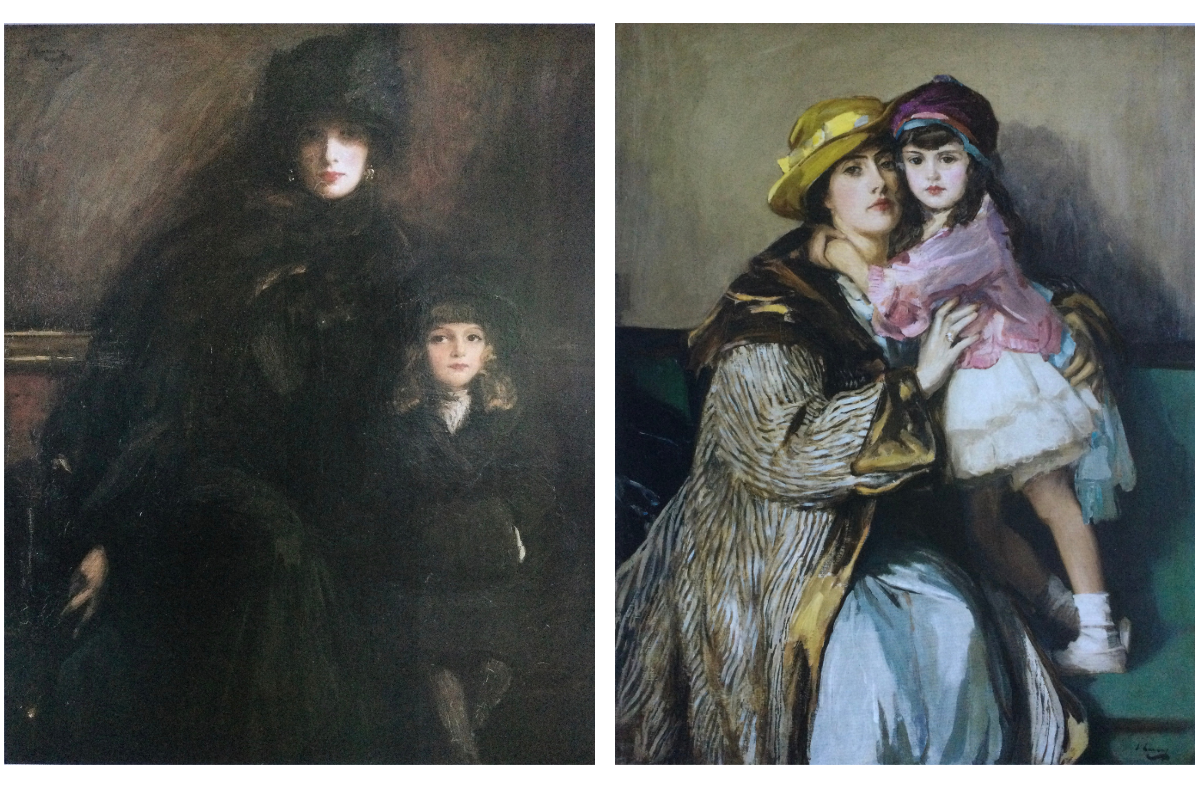

3 February 2025
VIEW LOT REQUEST A VALUATION CONTACT A SPECIALIST
For Walter Shaw Sparrow, writing his monograph on John Lavery in 1911, the artist's Portrait Group (Père et Fille) 1897-1900 (Musée d'Orsay, Paris), was clearly 'a very outstanding picture' (fig.1).1 A centrepiece in the French contemporary collection, it was widely exhibited and reproduced. As a portrait of the artist's beloved six-year-old daughter, Eileen Marion Lavery, with himself hovering in the background, it was intimacy made public – she in a fresh frock, and he, dressed for the street rather than the studio.2 Already known for painting double portraits when it was purchased in 1900, Lavery continued to be fascinated by the comparison of faces and the overlapping of sitters in the same picture. And while he travelled extensively for portrait commissions in the Edwardian years, and established a winter studio for seascapes and Oriental scenes in Tangier, he occasionally returned to pairings of figures in his work. It was when married to Hazel Trudeau and appointed Associate of the Royal Academy, as Shaw Sparrow was preparing his monograph, that the artist had embarked upon La Belle Mère (fig.2).3

Fig.1 John Lavery, Portrait Group (Père et Fille) 1897-1900, 208 x 126.5cm, Musée d'Orsay, Paris, Fig.2 John Lavery, La Belle Mère, 1911, the present picture
In this instance, as with the Orsay canvas, there was a special 'family' significance in his subject. On 22 July 1909, the painter, a widower since 1891, had married Mrs Hazel Trudeau, a widow since 1904, with a five-year-old daughter, Alice. They entered a world that in the previous decade had seen numerous celebrities pass through the artist's spacious studio at 5 Cromwell Place, in Knightsbridge. Bringing his new domestic arrangements together in 1910, and in preparation for the International Exhibition in Rome, Lavery conceived the idea of painting a large studio interior modelled on Velázquez' Las Meninas, with Hazel, Alice and Eileen as its principal actors. But this, when it returned from the exhibition, required extensive reworking and would take a further three years to complete (fig.3).4

Fig.3 John Lavery, The Artist's Studio, 1910-13, 344 x 274 cm, National Gallery of Reland, Dublin
La Belle Mère relates closely to this important project. It indicates that Hazel was quickly slipping into Lavery's social world of private views, Academy dinners and society soirées, that in 1911, surrounded sittings from Lady Gwendoline Churchill, Anna Pavlova, the socialite Ruby Peto, the haunting Mme Robert de Billy and others.5 Described as the 'most beautiful girl in the Midwest' and a Chicagoan of Irish/American descent, Hazel was becoming a valuable asset - 'in love with the spectacle of life' finding 'her true art' as a hostess, according to her husband.6 To this should be added the role of model since, in 1927, Lavery was commissioned to paint her portrait as Kathleen ni Houlihan for the Irish Free State currency. In the present instance, Eileen, soon to be married in the following March, accompanies her and both are dressed for a ball or evening reception during the London season.7
Two further canvases demonstrate the direction Lavery's 'family' subjects take before and after La Belle Mère, both entitled Mother and Child. The first, representing Hazel and Alice, then aged five, was painted shortly after their arrival in Cromwell Place, and the second, showing Eileen and her daughter, Diana, then aged four (figs.4&5). The first is a Whistlerian harmony in brown and black, while the second places Lavery in contention with younger artists like Laura Knight, Hilda Fearon and Harold Speed who delighted in the new freedoms accorded by contemporary fashions.

Fig.4 John Lavery, Mother and Child, (Hazel and Alice), 1909, 127 x 101.6cm, Hugh Lane Gallery, Dublin, Fig.5 John Lavery, Mother and Child, (Eileen and Diana), 1917, 120 x 94.5cm, Private Collection
Lavery remained supremely sensitive to harmonies of colour and tone, even when his palette has lightened, and a greater spontaneity had emerged in his handling. Poised between these works, La Belle Mère demonstrates a willingness to bring something new to an old idea. While in The Artist's Studio Hazel and Eileen appear in natural light, here the artist experiments with a flickering firelight palette. The flaring and fading of such a light source accounts in part for the pace and sketch-like quality of the ensemble, and the variation in application between foreground and background figures.8 In purely personal terms, there could be nothing more significant than bringing his two favourite models together.9
Kenneth McConkey
January 2025
1 Waller Shaw Sparrow, John Lavery and his Work, 1911 (Kegan Paul, Trubner, Trench & Co.), p.138.
2 Kenneth McConkey, John Lavery, A Painter and his World, 2010, (Atelier Books, Edinburgh), pp.71-74; also Kenneth McConkey, Lavery on Location, 2023 (exhibition catalogue, National Gallery of Ireland, Dublin), no. 57, pp.132-3. Born in March 1891, to Lavery's consumptive first wife, the former London flower seller, Annie Evans (aka Katheen McDermott), Eileen's early years were spent in Scotland, before her move to be with her father to London in 1898. Her mother died within six months of her birth.
3 Notable precedents for double portraits, include Mother and Son, Mrs Lawrie and Edwin, 1891 (Galleria Civica d'Arte Moderna, Venice), Anne Montgomery Knox and her father, 1896-7 (Private Collection) and Mrs Plowden and Humphrey, 1897-8 (Private Collection).
4 McConkey 2010, pp.108-111.
5 For Lady Gwendoline Churchill and Mme Robert de Billy, see McConkey 2010, pp.108-109 and notes 15&16); for Ruby Peto, see Whyte's Dublin, 25 May 2015, lot 30 – catalogue note by Kenneth McConkey; and for Pavlova, see Kenneth McConkey, 'Pavlova and her Irish painters', Irish Arts Review, Winter 2024, vol. 41 no. 4, pp.126-131.
6 John Lavery, The Life of a Painter, 1940 (Cassell), pp.195, 197. Born Hazel Martyn, (1880-1935), daughter of a wealthy Chicago stock yard company vice-president, she was betrothed to a young doctor, Edward
Livingston Trudeau, when she first met Lavery in 1903. When Trudeau's sudden death in 1904 left her pregnant with Alice, she and Lavery retained sporadic contact. Following their marriage, she blossomed as a leading society hostess; see also, Sinéad MacCoole, Hazel, A Life of Lady Lavery, 1880-1935, 1996 (Lilliput Press Ltd., Dublin). Cecil Beaton in The Book of Beauty, 1930 (Duckworth & Co.), pp.53-55, would later describe 'the cutting of her features' as 'perfection' and Hazel's 'complexion like white china, her cheeks like the fire through china, her hair bright red', and 'with her preference for lipstick and powder she is like a very sophisticated squirrel'. He further recalls that 'with her love of 'ostrich plumes', as in the present work, she was 'different from other beauties – isolated, melancholy, wise – a rare and romantic being'.
7 Eileen, following Portrait Group (Père et Fille), had featured frequently in Lavery's work and was currently the subject of The Amazon 1908-10 (Ulster Museum, Belfast) the artist's principal work at the Royal Academy in 1911. She married James Dickinson in Tangier the following year.
8 Lavery may well have planned to continue working on La Belle Mère but was prevented from doing so by the death of Hazel's younger sister, Dorothea, necessitating an unplanned trip to Chicago in October 1911. Not long after their return to London, they set sail for their annual winter sojourn in Tangier.
9 As is well-known, both sitters died in 1935 within seven months of one another, when the artist was entering his eightieth year; see McConkey 2010, pp.192-195.
privatecollections@sworder.co.uk | 01279 817778
3 February 2025
Leading the 25 & 26 March Fine Interiors auction are the selected contents of Tile Barn, Northamptonshire, former home of Charles Edwards and Julia Boston.
31 January 2025
La Belle Mère, an intimate work by Sir John Lavery, will feature in our 4 March sale: Better by Design | The Principal Contents of Boden Hall.
29 January 2025